|
Recomended Shaolin DVDs for Beginners
To watch a video clip preview simply click the picture link on the left
Shaolin Basic Skills
Shaolin Basic Skills assembles
all the esoteric methods of practicing kung fu in Shaolin Temple.
It consists of the exercise of techniques of hand, eye, body and foot and the combination of movements. Long-period practise
of the Shaolin Basic Skills can provide you a firm base to further learning of the traditional Shaolin Boxing. In this program
you can appreciate, understand, and learn from the wonderful Shaolin Basic Skills. unpredictable .
Eighteen Methods of Traditional Shaolin Kung Fu
Eighteen Methods of Traditional Shaolin Kung fu is a development from Shaolin Basic Skills. If you bought the
Shaolin Basic Skills DVD this is a good next step. Click Picture for more information and to buy.
Shaolin Elementary Changquan
Shaolin Elementary Changquan is one of the first elementary boxing
series in Shaolin Kung fu. Its movements are well arranged and regarded as the standard with the degree of difficulty. In
whole routine consist of the different basic methods of hand, leg and jumping movements. You can practice it more often to
constantly improve the strength, speed, endurance and other physical qualities and improve the interest for wushu.
Intermediate, Advanced and Specialised Shaolin DVDs
Shaolin Five Animal Kung Fu
An excellent series of tutorial DVD's on one of the most fascinating and effective aspects of the Shaolin
arts. Each DVD teaches a specific animal - develop the speed of the Leopard, power of the Tiger, grace of the crane, the Qi
of the Snake and the mind of a Dragon!
| Shaolin 5 Animal |
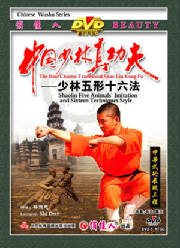
|
| DVD |
Shaolin Five Animal Imitation and Sixteen Techniques Style
In the sprit of five animals, the movements of roosters, horses, and tigers are emphasized. Adopting the fighting techniques
of the five animals-the peck of the rooster, the kick of the horse, the crouch of the tiger, the jump of the rabbit, and the
twist of the dragon, created this style. Sixteen hand-Skills, step-skills and kick-skills were established basing on them
.The change of the techniques is hidden in the coordination of the imitation. The movements are forceful, agile, and practical
in combat. Click picture for more info.
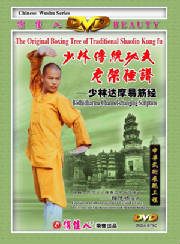 Bodhidharma Chanel-changing Scripture
Bodhidharma channel-changing Scripture is one of the earliest exercise method that were practiced
by Shaolin Buddhist monks. According to the experiences through thousands of years, it does have the benefit of keeping health.
It was said that it was produced by Bodhidharma. This method could combine spirit, body and qi together closely. And it could
also regulate vital organs of the human body, twelve meridians and the whole body overall. It helps balance yin and yang,
unblock meridians and muscles, then strength physiological functions of human body to keep health, avoid illnesses and prolong
life span.
Seven Star Boxing
This boxing is the most popular boxing in Shaolin Temple area .It
imitates the places of the seven stars in the northern pole sky .Its posture is make of unique steps and footworks .Step type
requires two feet standing on a line, called Small Compact Body .The attack of this routine is absolutely unpredictable .
Shaolin Arm-Through Boxing
Brief Introduction: This
boxing is created by the common efforts of Shaolin warrior monks of one generation after another. It uses the arms as the
source of forces while keeping the palms, fists, elbows in quick movements. In barehanded combats, the player often sweeps
his arms to attack the enemy. Foot movements often used are bow step, horse-riding step, crouch stance, push palms in bow
steps, pat the feet and smash with the fists.
Shaolin Baji Quan
This is a practical routine
in Shaolinquan. Movements such as plant, hammer and strike should be conducted forcefully and quickly as if he was fighting
a tiger in a forest. While performing, you should move like the wind, stand like a nail with your eyes as bright as lightning,
or flash your punches on the enemy. All of the movements are conducted almost in one breath.
Shaolin Big Cannon Boxing
This boxing is the king of Shaolin Boxing .The eminent monks select
out some essential movements from the primitive routines at the initial stage and the outstanding routines of numerous Shaolin
Wushu to form an intact pattern systems ,in order to look for a kind of unique skill. Frequently used techniques are twisting
the body and rolling .
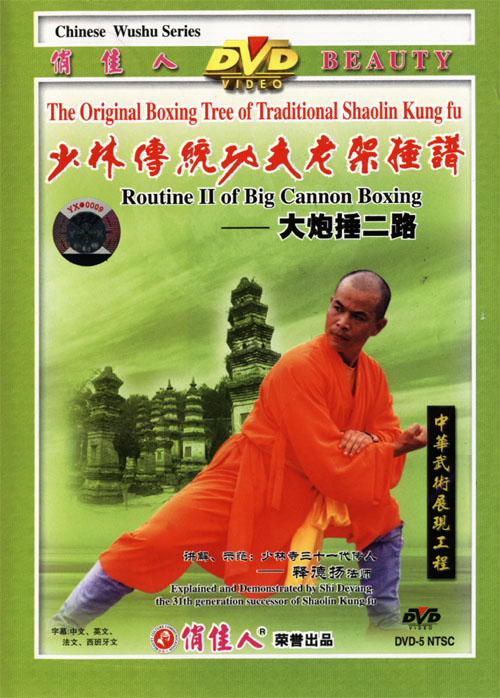 Shaolin Big Cannon Boxing DVD 2
Shaolin Mizong Quan is one of the most representative boxing in the Shaolin Wushu system. Being simplified
and enriched by many generations of eminent monks, its content is more perfect and its structure is more compact. Shaolin
Mizong Quan has its own unique characteristic: the movements are natural and extending; the forms are fierce, forceful, powerful,
simple and unadorned; the hand techniques are unique; the foot techniques are changeable; it stresses on actual combat and
is good at confusing the opponent by making a feint to one direction and attacking the other, then it can make the opponent
at a loss. Practicing the Shaolin Mizong Quan frequently can have a special effect of improving your level of Kungfu and increasing
your strength.
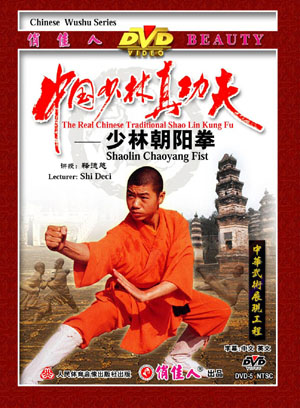 Shaolin Chaoyang Fist
Chaoyang (facing the sun) Fist is a practical combat style. Movements such as cut fist, soaring shell, forward push,
and punching the ears with double fists are very useful. The practitioner attacks or defends, feints or traps, all with quick
changes and with linked movements.
Shaolin Da Hong Quan
Da Hong Quan is the most highly prized style in the Shaolin
Temple, and was taught only to Shaolin warrior monks. It is a comprehensive
routine of hand techniques,footwork, and kicking techniques. At the same time, it is an indispensable routine for advanced
Shaolin wushu learners.
Shaolin Dragon Fist
Dragon Fist belongs to the Shaolin 8 animal-imitation series. The
animals usually imitated are rooster, sparrow, horse, buffalo, tiger, rabbit, snake, and dragon. In Chinese mythology, dragon is formlessly agile and changeable, and so this dragon-imitation
hand form is characterized by changing movements.
| Monkey Claw |

|
| DVD |
Back-through Shaolin Monkey Shape Boxing
This boxing is created by Shaolin Wushu monks who adopt the advantages of Small Hong
Boxing,Big Hong Boxing, and Monkey Boxing . Its characteristic is pretty and cleverly-made, lively and agile. Hand type is
mostly monkey's claw.
This routine is lively and clever. It is active to whole body joint and has effect on building up body and exercising
techniques of attack and defends. It is very popular with the warriors and suitable for teenagers. This boxing is according
to the demonstration movement of Su Xi who is a famous monk..It is easy to study
and practise and popularize. This is the first of three DVDs. Click picture for more info.
Also:
Shaolin Drunken Boxing
This popular style imitates the chaotic and unpredictable motion of a drunkard. Large swaying movements are used to avoid
attacks and to strike from unexpected directions. Click picture for more information and to buy.
Shaolin Eagle Claw Boxing
A popular style today Shaolin eagle-claw kung fu has a heavy emphasis on joint locks combined with jumping techniques.
A very impressive and beautiful style to watch with many effective counters. Click picture for more information and to buy.
Shaolin Eight Step Interlink Fist
Shaolin Eight Step Interlink
Quan consists of two sections executed with eight steps, seven methods of fists, three methods of palm, four methods of leg
and two methods of catching hold, one defensive posture and one ready posture and two repeat postures. This routine is short,
quick, with clear attacking and defending and special change methods, has twenty-two changes in eight steps, and so we can
see how strict its skill is.
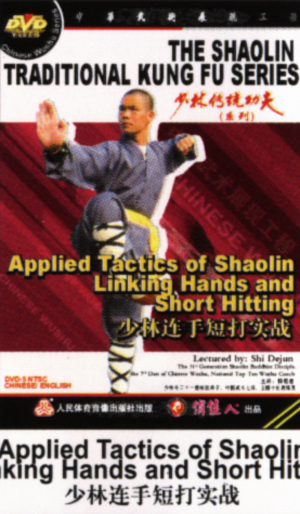 Applied Tactics of Shaolin Linking Hands and Short Hitting
Shaolin Linking
hands and short Hitting called also Shaolin Body-protecting quan. Its movement is extending with firmness and softness, contents
both defending and attacking. When demonstrating it, step comes with hands, the change of body is variety, the posture is
linking, one by one, when attacking enemies, we take advantage of goring by shoulder, striking by head, fighting by elbow,
depending by hip, stumbling by feet, catching by hand, and hitting by fist, etc, shows completely the perfect points of kicking,
hitting, throwing and catching, is a rare routine.
 Shaolin Defending the Heart Fist
This is a representative
routine in the Shaolin Fist series. "Defending the heart," means keeping calm and peaceful, controlling your desires as if
sitting still and meditating. The moves are preceded by complete stillness. The change from stillness to move takes place
in the blink of an eye. One movement leads to another. Your attacks should be as heavy as Tai Mountain and your steps as light as a feather. Your energy and attention should be coordinates
as one. The main techniques are forward lunge, horse stance, empty step, rest-stand step, crouching step, pushing palm, twisting
hand, and pat the feet.
Shaolin Fanzi (tumble) Boxing
Brief Introduction: Fanzi
Boxing is one of the Shaolin Boxing series. The player mainly uses the body movements such as side move, tumble and turn over,
as if a dragon whirling in the cloud. The often used steps are horse-riding step and dragon step.
Shaolin Guandong Fist
This form was created
by Shaolin monks who adopted the essential movements of other schools, especially a hand form which is very popular in Northeastern
China called Guangdong Quan (guandong refers to Northeastern China.) This form is very powerful. While performing, your fists and feet
are used together with some blocking and some kicking. Each movement is made clearly. You quickly stretch, turn, advance,
or withdraw while breathing in and out rhythmically. Frequently used techniques are twisting hand, pressing palm,rebounding
fist, snatch, moving in forward lunge, horse stance, and crouching step.
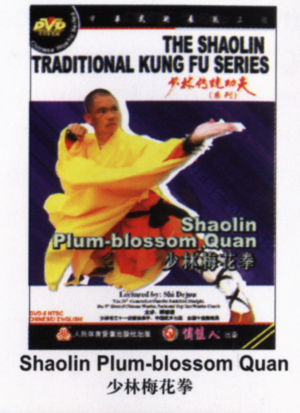 Shaolin Plum Blossom Quan
Plum-blossom Quan is one
of excellent routines of traditional Shaolin Wushu. Actions of this routine are decent, with integral structure and distinctive
style. When performed or practiced, thrust in the front and strike at the back, jump from the left and fall to the right;
the actions heave and set, being most changeful, and postures are interlinked. Because this routine looks like the shape of
plum blossom, thus it is named plum-blossom quan, which is suitable for the person who has certain wushu base to perform or
practise.
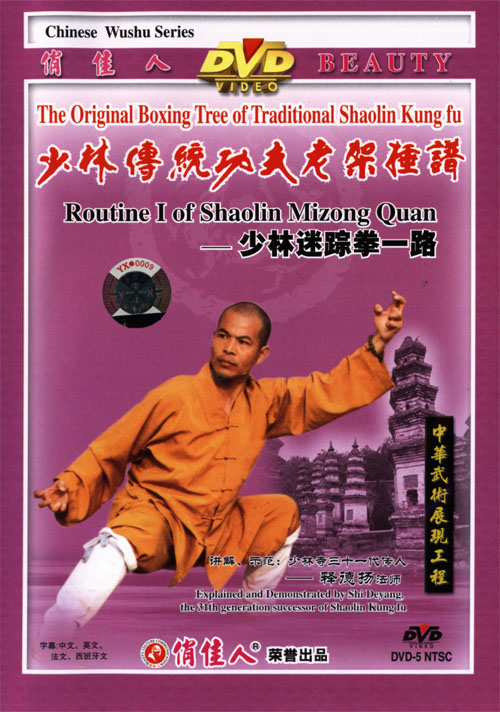 Shaolin Mizong Quan
Shaolin Mizong Quan is one of the most representative boxing
in the Shaolin Wushu system. Being simplified and enriched by many generations of eminent monks, its content is more perfect
and its structure is more compact. Shaolin Mizong Quan has its own unique characteristic: the movements are natural and extending;
the forms are fierce, forceful, powerful, simple and unadorned; the hand techniques are unique; the foot techniques are changeable;
it stresses on actual combat and is good at confusing the opponent by making a feint to one direction and attacking the other,
then it can make the opponent at a loss. Practicing the Shaolin Mizong Quan frequently can have a special effect of improving
your level of Kungfu and increasing your strength.
Also:
| Shaolin Mizong Quan 2 |

|
| Advanced Routines |
Shaolin Thirty-Two Methods of Chin Na
Qin Na is one of the four
fight skill " kicking, hitting, throwing, (Na) catching" in Wushu. Its main way is to catch the tendon or twist joint, which
let the adversary fold joints and hurt hardly, loosing his ability to resist. It contents thirty-two forms such as catching
wrist, elbow, knee and head, etc. There are the fight skills that are particular for both catching and throwing.
Shaolin Seven Star Mantis Quan
The Mantis Quan a pictograph boxing which created by Wang Lang, a master who research the fighting skill of cutting,
chopping and twisting when the mantis catching cicadas, and then Wang Lang came into Shaolin Temple for three years and instruct
the mantis boxing to monks. This routine contents both firmness and softness, uses short thing and long thing, hands and feet,
compact and clear, the whole force is round, the whole body coordinates and change unstop.
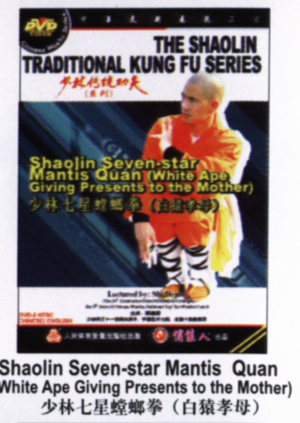 Shaolin Seven-Star Mantis Quan: White Ape Giving Presents to the Mother
Seven-star mantis quan
is a kind of shape-simulating boxing, which was developed and compiled by Wang Lang, a boxer at early Qing Dynasty, applying
the capturing and fighting skills of the two arms when he researched the scene of mantis capturing cicada. Later, Wang Lang
stayed at Shaolin Temple for 3 years, and taught mantis
boxing to the monks of this temple. White Ape Offering Fruit is one of the routines in seven-star mantis boxing, which uses
the temper force with grace, both long and short actions, harmonious and consistent actions of the hands and feet, forthright
rhythm, integral strength and complete force, the actions of hook, grad, twining and closing, being coherent, compact and
most changeful.
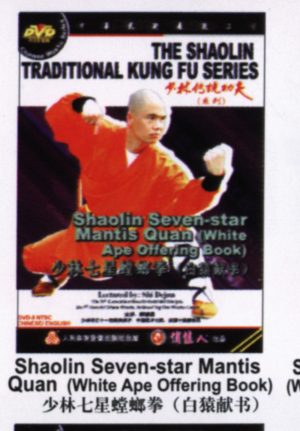 Shaolin Seven-Star Mantis Quan: White Ape Offering Book
Seven-star mantis quan
is a kind of shape-simulating boxing, which was developed and compiled by Wang Lang, a boxer at early Qing Dynasty, applying
the capturing and fighting skills of the two arms when he researched the scene of mantis capturing cicada. Later, Wang Lang
stayed at Shaolin Temple for 3 years, and taught mantis
boxing to the monks of this temple. White Ape Offering Fruit is one of the routines in seven-star mantis boxing, which uses
the temper force with grace, both long and short actions, harmonious and consistent actions of the hands and feet, forthright
rhythm, integral strength and complete force, the actions of hook, grad, twining and closing, being coherent, compact and
most changeful.
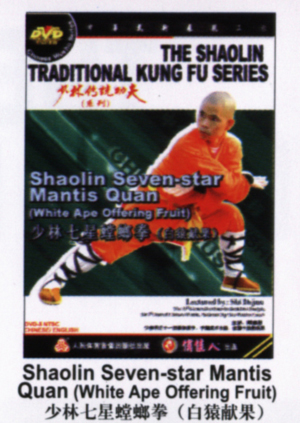 Shaolin Seven Star Mantis Quan: White Ape Offering fruit
Seven-star mantis quan
is a kind of shape-simulating boxing, which was developed and compiled by Wang Lang, a boxer at early Qing Dynasty, applying
the capturing and fighting skills of the two arms when he researched the scene of mantis capturing cicada. Later, Wang Lang
stayed at Shaolin Temple for 3 years, and taught mantis
boxing to the monks of this temple. White Ape Offering Fruit is one of the routines in seven-star mantis boxing, which uses
the temper force with grace, both long and short actions, harmonious and consistent actions of the hands and feet, forthright
rhythm, integral strength and complete force, the actions of hook, grad, twining and closing, being coherent, compact and
most changeful.
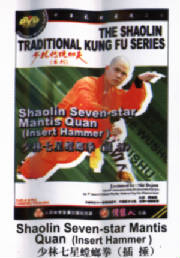 Shaolin Seven-Star Mantis Quan: Insert Hammer
Seven-star mantis quan
is a kind of shape-simulating boxing, which was developed and compiled by Wang Lang, a boxer at early Qing Dynasty, applying
the capturing and fighting skills of the two arms when he researched the scene of mantis capturing cicada. Later, Wang Lang
stayed at Shaolin Temple for 3 years, and taught mantis
boxing to the monks of this temple. White Ape Offering Fruit is one of the routines in seven-star mantis boxing, which uses
the temper force with grace, both long and short actions, harmonious and consistent actions of the hands and feet, forthright
rhythm, integral strength and complete force, the actions of hook, grad, twining and closing, being coherent, compact and
most changeful.
 Appreciation of Shaolin Taizu Quan and its Weapons
Taizu Quan (Taizu Boxing)
is one of the chief boxing styles in traditional Chinese Wushu and Taizu Changquan is one of the eighteen Shaolin styles.
It is said that Taizu Quan is honored as No One boxing because it was created by Song Taizu (the first emperor of the Song
dynasty).He created sixteen routines of Chang Quan .However six routines such as Hua Quan, Hua Quan -Routine I and Hua Quan-Routine
II .This disc demonstrates some routines such as Taizu Chang Quan and Short Cudgel to the Kung fu players. Click picture for
more info and to buy.
More Shaolin Training DVD's
|

